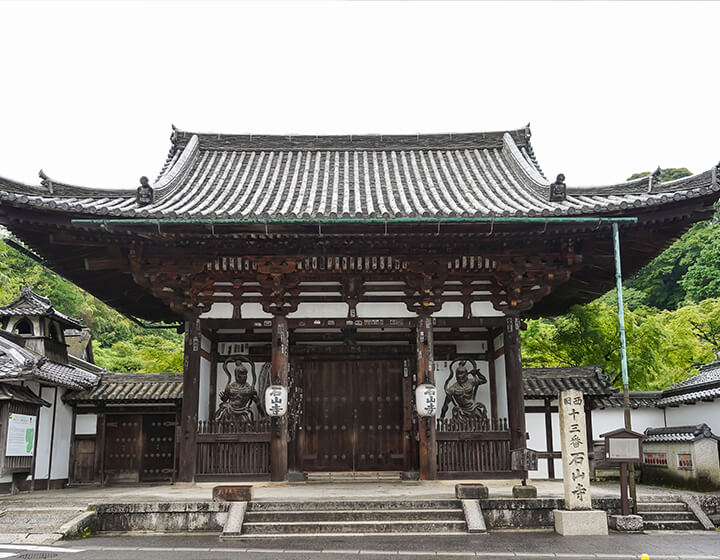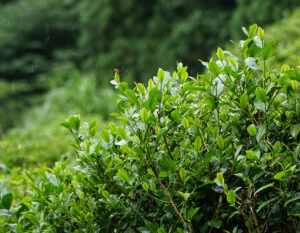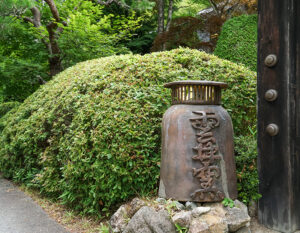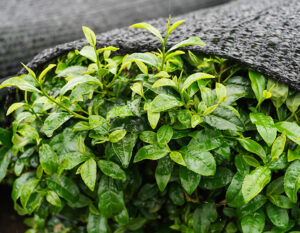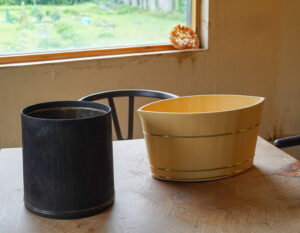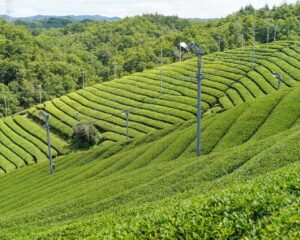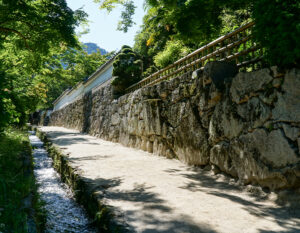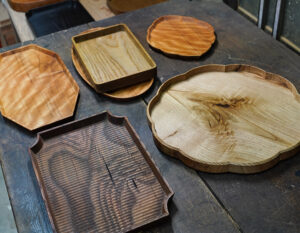Shiga Prefecture, once the capital of Japan at Otsu-kyo and twice at Shikaraku-gū, has long flourished as a strategic location for land and water transportation, and is home to a treasure trove of historic shrines and temples. One of its representative temples is Ishiyama-dera Temple, known as the site where Murasaki Shikibu began writing “The Tale of Genji”. We visited the temple, which stands on the banks of the Seta River connecting Lake Biwa and Kyoto.
A scenic temple known as one of Shiga’s best spots for viewing the autumn leaves
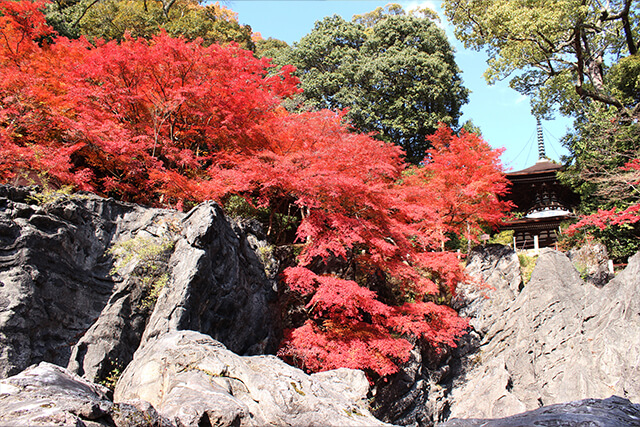
Ishiyama-dera Temple, located at the tip of Lake Biwa in southern Shiga Prefecture, is popular mainly in the Kinki region as a scenic temple, especially during the seasons of Japanese apricots, cherry blossoms, green maple trees, and autumn leaves. It is also known as one of the best spots for viewing the autumn leaves in Shiga. The secret of the temple ‘s popularity is its proximity to the city center and its easy accessibility: a 10-minute walk from the nearest station, Keihan Ishiyama-dera, and less than a 30-minute train ride from Kyoto.
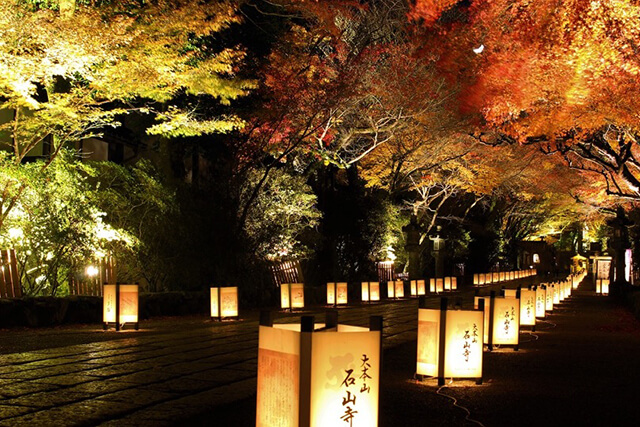
Todaimon Gate was donated by Minamoto no Yoritomo. The statue of Niou is by Unkei and Tankei.
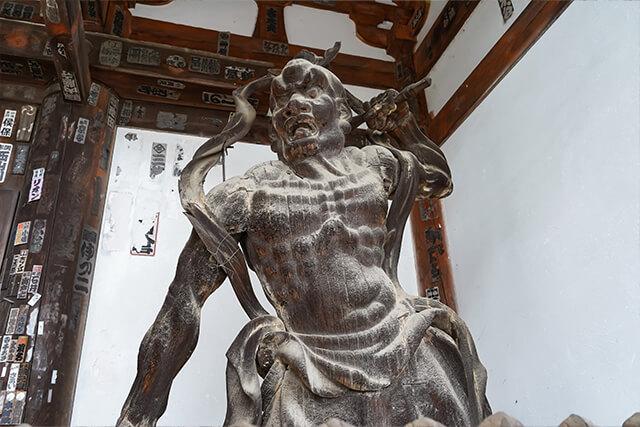
The first thing that greets visitors is the Higashidaimon Gate, designated as a national important cultural property. The gate was donated by Minamoto no Yoritomo and repaired in the Momoyama period (1573-1600) by Yododono, a lady consort of Toyotomi Hideyoshi, and is flanked by two Nio statues by Unkei and Tankei. After bowing to the imposing appearance of the irimoya (gabled roof) structure with a kawarabuki-roof, visitors proceed to the approach to the temple.
The scenery created by the “silica stone,” a national natural monument, which gave the temple its name.
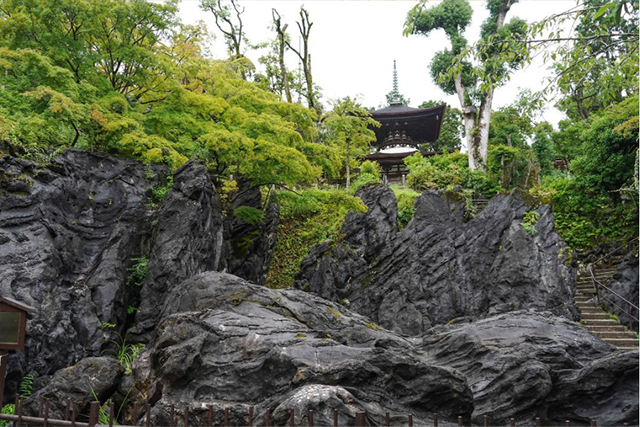
As we make our way toward the main hall, we are suddenly confronted by a huge rock with a mysterious shape reminiscent of splashing waves. It is a ” silica limestone,” which is designated as a national natural monument. Beyond it is the elegant pagoda (national treasure), built with contributions from Minamoto no Yoritomo, which is said to be the oldest pagoda in Japan. This scenery, which makes you feel as if you have entered a landscape painting world, is the symbol of Ishiyama-dera Temple.
The temple is located on a 239-meter-high mountain called Garanzan, which is a “stone mountain” with silica limestone protruding everywhere, and Seoksan-ji Temple stands on a bedrock of limestone. This is the origin of the name “Seoksan-ji Temple.
The temple was founded in 747, and the first female head of the temple will be born in 2021.
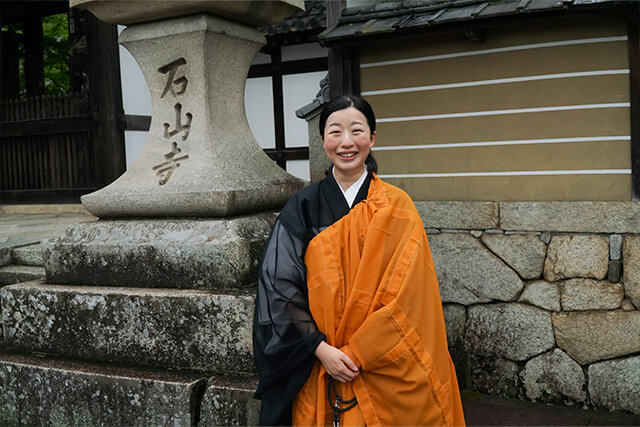
Ishiyama-dera Temple was founded in 747. The temple was built by the order of Emperor Shomu, who was the first abbot of Todaiji Temple in Nara.
However, during the Heian period (794-1185), when esoteric Buddhism such as the Shingon and Tendai sects became popular, the temple became a center for the esoteric Shingon sect. The first head priest was Rigen Daishi Seiho of Daigoji Temple, the second head priest was Kangen, a disciple of Seiho, the third head priest was Junsuke Uchikyu, a grandson of Sugawara no Michizane, and the 53rd head priest is currently Ryuka Washio.
Born to her grandfather, Takateru Washio, the 51st head priest, and her father, Henryu Washio, who later became the 52nd head priest, Washio became the first female head priest in the long history of Ishiyama-dera in December 2021. She says, “I was born and raised in these precincts and have wanted to be a monk since I was a child, so my dream has come true.”
The main hall, a national treasure, where architectural styles of the Heian and Momoyama periods coexist
Next, Mr. Washio led us to the main hall, a national treasure built on a silica stone. The inner sanctum (main hall), which houses the principalimage of Nyoirin Kanzeon Bosatsu and a number of other Buddhist statues, including Yakuyaku Fudo Myoo, said to have been created by Kobo Daishi, was built in the Heian period (794-1192), and is the oldest wooden structure in Shiga Prefecture.
The outer sanctum of the main hall (Reidō ), which was built during the Momoyama period (1573-1600) with a donation from Yododono, uses the same ” kake-zukuri ” style of construction as the main hall of Kiyomizu-dera Temple in Kyoto. It is said to be extremely rare to find a mixture of styles from two different periods in one main hall.
The main image of the temple is Japan’s only imperial seal hidden statue of Buddha. The Gokaicho is held once every 33 years and the year after the accession of the Emperor to the throne.
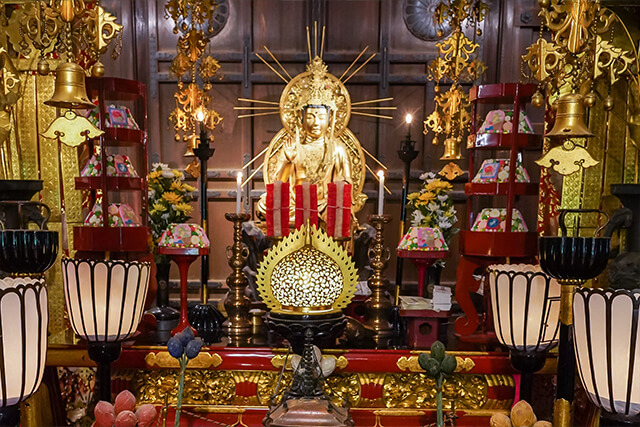
The principal object of worship at Ishiyama-dera Temple is the secret statue of Nyoirin Kannon Bosatsu, which is designated as an important cultural property of Japan. In front of the kitchen in the inner sanctuary where the hidden Buddha is enshrined is the golden “Gozenritsuzon”.
Beyond the kitchen sits Nyoirin Kannon Bosatsu, a very large wooden Buddha standing 1.6 meters (5.3 m) tall. Created in the Heian period (794-1185), it is the only “imperial sealed Buddha” in Japan, sealed by order of the emperor.
The seal is broken and the statue is opened once every 33 years (the next time will be in 2047), and the year after the emperor’s accession to the throne. At the opening ceremony, the doors are solemnly opened in the presence of an imperial envoy (a messenger from the emperor). This has continued since the Nara period.

Since the statue is a hidden Buddha, it can only be viewed during the opening ceremony, but visitors are encouraged to imagine what the statue actually looks like as they look at the Kannon carved on a thin copper mirror known as a kakeboteke.
The Nyoirin Kannon is said to be a half-lotus statue with the left leg down, sitting on a rock, and is enshrined in the form of a triad with Zao Gongen, the god of the mountains, on the left, and the Deity of Vajra on the right, who is worshipped at Todaiji Temple, which has been closely associated with Ishiyama-ji since its foundation.
The Nyoirin Kannon is usually depicted with six arms (roppi, meaning six arms), but the Nyoirin Kannon of Ishiyama-dera Temple is said to have two arms, which is a more ancient form.
The “Temple of the Three Kannon Temples” along with Kiyomizu-dera Temple and Hase-dera Temple
Nyoirin Kannon has been worshipped as the Goddess of Mercy for safe delivery, good fortune, marriage, and protection from bad luck. Even today, many young women are said to come to the temple to seek such blessings.
In the Heian period (794-1185), Ishiyama-dera Temple was called the “Three Kannon Temples” along with Kiyomizu-dera Temple in Kyoto and Hase-dera Temple in Nara, and ” Ishiyama-mode” (pilgrimage to Ishiyama) became popular among aristocrats in Kyoto. The aristocrats of Kyoto were tired of their daily lives in the capital and wanted to visit Ishiyama, where they could enjoy the relaxing atmosphere. People of that time must have felt this way,” says Washio. Surrounded by the greenery of Mt. Kyanzan, I feel the strong persuasive power of his words as I sit in the main hall overlooking Lake Biwa.
On the night of the Fifteenth Night, “The Tale of Genji” was born here.
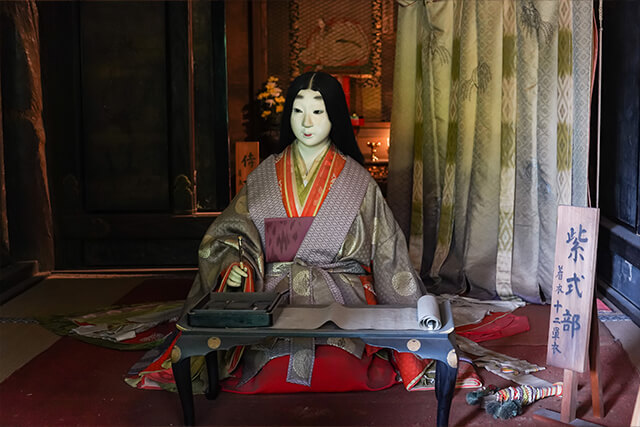
Incidentally, among the aristocrats who made pilgrimages to Ishiyama during the Heian period were Murasaki Shikibu, author of ” The Tale of Genji,” as well as famous women literary figures such as Fujiwara Michitsuna, mother of the author of “Dragonfly Diary,” and Sugawara Kojojo, known for her “Sarashina Diary. These women are said to have performed “sangoro,” a ritual of staying in a hall and praying throughout the night.
One of the most famous episodes is the legend that Mur asaki Shikibu wrote “The Tale of Genji” at Ishiyama-ji Temple. 1004, when the prince of the time asked her to write a new story, she spent seven days in the temple to write it. That day was the harvest moon of mid-autumn. As she gazed at the moon reflected on Lake Biwa, a scene came to mind of a nobleman who had been exiled from the capital of Kyoto to Suma, looking at the moon and pining for the capital. He then wrote, “Tonight is fifteen nights,” which is said to be the beginning of “The Tale of Genji.
This legend is recorded in various books including “Ishiyama-ji Engi Emaki” (Ishiyama-ji Temple Engi Emaki), and in a corner of the main hall, there remains a room called “Genji no Ma” where Murasaki Shikibu is said to have written “The Tale of Genji”.
Matsuo Basho stayed at the temple during the Edo period and Shimazaki Toson during the Meiji period.
In the precincts of Ishiyama-dera Temple, there is also the pagoda house “Mikura-in,” where the young Shimazaki Toson stayed for two months (the building in front of the temple gate was moved to the precincts in 1969), and a monument with haiku poems by Matsuo Basho. Also near the temple is the “Genju-an” where Basho lived temporarily.
Basho visited Ishizaki and composed the haiku “Ishiyama no ishi ni tabashiru ararekana” and “Akebono no wa murasaki ni hottogisu,” while Toson wrote essays and children’s stories about his stay at the time.
The natural beauty of the scenic temple and the power brought by the Kannon (Goddess of Mercy) may have made him do so. Ishiyama-dera has continued to inspire writers of various periods.
A temple that can be a source of comfort in troubled times.
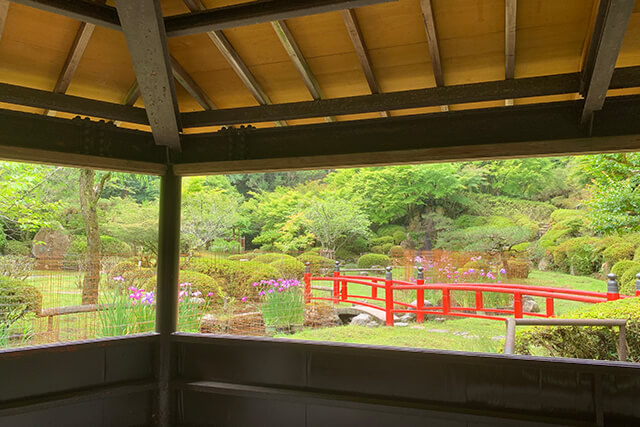
Ishiyama-dera Temple was and still is visited by many people, and is also known as the “temple of flowers.
Around late February, 400 plum trees of about 40 varieties in three plum orchards on the temple grounds herald the arrival of spring, followed by 600 cherry trees of various varieties that decorate the temple grounds. After that, seasonal flowers such as Kirishima azalea (over 300 years old),iris, wisteria, iris, peony, hydrangea, and sazanka (a type of cherry blossom) soothe visitors’ hearts.
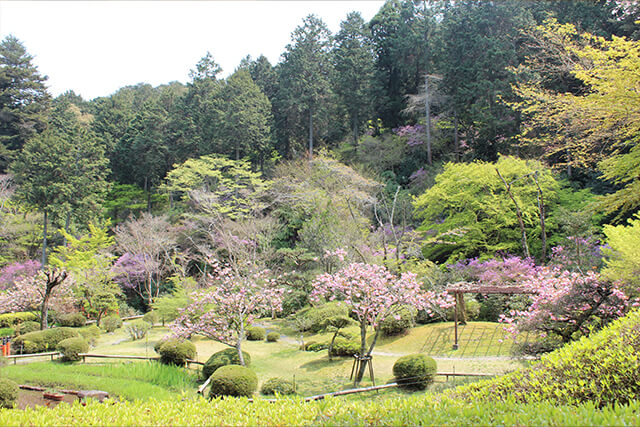
Many of the flowers are said to have been cultivated with great care by the zamoto (master), and the “Daiichi Plum Garden” is home to a collection of old plum trees cultivated by successive zamoto. The sazanka, which blooms from late fall to winter, was grown by the 51st headmaster, Washio’s grandfather, who loved it.
The flowers on the temple grounds bring us together with people from all walks of life, from those who come from far away to the locals,” Washio said. In these times of uncertainty, I hope the temple can be a place where people can find comfort in their hearts,” says Washio.
Free your mind by immersing yourself in the natural beauty of the temple grounds, where the sound of cars cannot reach you.
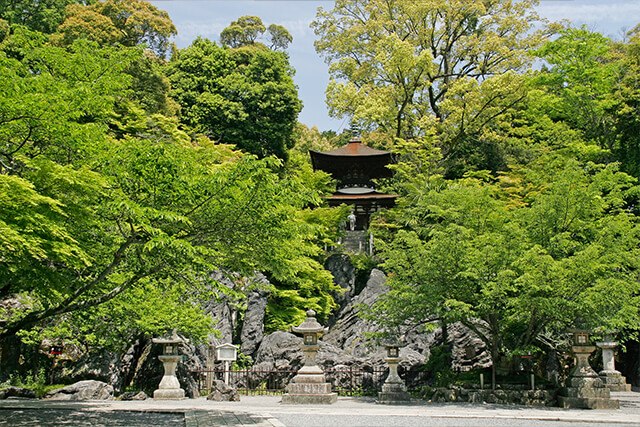
Since the temple grounds are located on a part of a mountain, the trees that have survived the long history of the temple are also beautiful. The 400-year-old sacred tree, called a ” thousand-year-old cedar,” the cedar forest that casts deep shadows even in summer, and the vivid contrast between the young maple leaves,autumn leaves, and limestone are popular as views that can be seen only here.
The sound of cars does not reach the temple grounds. The temple grounds are free from the sounds of cars, and visitors feel as if they have been cut off from the mundane world for a while, bringing with it a sense of relief. In fact, many visitors spend as much as half a day strolling the temple grounds.
The magnetism of Ishiyama-dera Temple, which has attracted many people over the years as a “place of prayer,” also resides in its beautiful nature, which allows visitors to relax and unwind.



